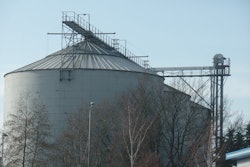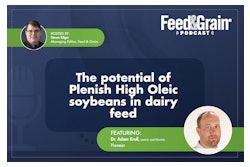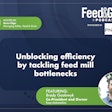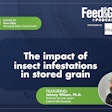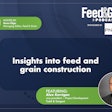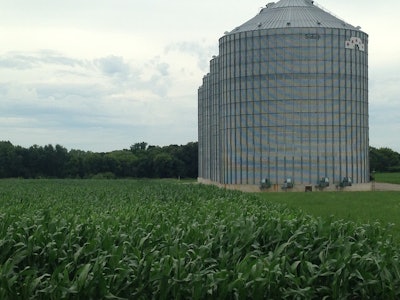
In this episode of the Feed & Grain Podcast, host Steven Kilger engages in a vital conversation with Jess McCluer, vice president of Safety and Regulatory Affairs at the National Grain and Feed Association (NGFA), and Joe Mlynek, content creation expert and partner at Safety Made Simple. The trio explore the repercussions of a high-moisture corn harvest, discussing grain quality management, safety concerns and practical tips to navigate these challenges.
Transcript has been edited for clarity.
Steven Kilger: Hi, everyone, my name is Steven Kilger. I'm the managing editor of Feed & Grain and the host of the Feed & Grain Podcast. Thank you so much for joining me today as we dive deep into the issues affecting the feed manufacturing, grain handling, and allied industries.
Today, I'm talking with Jess McCluer, vice president of Safety and Regulatory Affairs at the National Grain and Feed Association, also known as NGFA, and Joe Mlynek, content creation expert and partner at Safety Made Simple and consultant at NGFA. Plus, he was a former podcast guest.
A fairly high moisture harvest has been reported by some in the Midwest. So we're here to discuss grain quality management and safety. It was an informative discussion about some tips on grain bin safety, keeping up quality with wet grain, and general tips about how to stay out of the grain bin altogether.
Before we start, if you're listening to this in a podcasting app, please rate us and subscribe. If you're listening online, sign up for the Feed & Grain newsletter Industry Watch to see the latest podcasts and stay up-to-date with us from around the industry. Thank you so much for listening. Now on to the show.
Hi, Joe. Jess, thank you so much for joining me today. Can you tell me and our listeners a little bit more about yourself and your history with the industry?
Jess McCluer: Well, sure, Steve, thanks very much for having us here on the podcast. I'll just start with a background. So I'm Jess McCluer, vice president, Safety and Regulatory Affairs. I've been with the National Grain and Feed Association for 16 years now. And my background prior to coming to NGFA is from a regulatory policy side. I worked at the Occupational Safety and Health Administration (OSHA) for about five years before coming over to NGFA to handle regulatory issues.
Joe Mlynek: I'm Joe Mlynek. I am an independent safety consultant and also work with the company and I'm a partner in, a company called Safety Made Simple. I've been in the grain industry for probably about 20 or 25 years. I started with the Andersons in 1999. And worked for them for 10 years. That's really where I really got exposed to the grain industry. From a safety standpoint, started consulting in the industry in 2010. Work for grain handlers all across the country from small to large, mainly performing assessments, developing programs delivering training, those types of things. In 2014, partnered with a gentleman out of Kansas City named Chuck Pirie. And we started Safety Made Simple. On the grain side, we have over 20,000 learners and about 70% of them are grain handlers.
I primarily develop all of the grain-related training as well as general industry construction for our online training. But glad to be here today and recently partnered with NGFA as a consultant. And Jess has me working on a project. We're updating some existing safety tip sheets, the NGFA Safety Manual, and some guidance documents. We're looking to deliver some webinars and 2024 and also possibly help out with some of the regional safety seminars that Jess delivers.
Kilger: For longtime listeners who have already heard the episode with Joe, a few months back on Safety Made Simple and their online education program. It was a great episode. If you haven't listened to it, please go find it. There'll be a link in the description. But for today, we're here talking because it was a kind of a wet fall. And there's been a lot of reports, especially in the midwest of high moisture levels in this year's corn harvest. Can you guys kind of give us an overview, of the current situation that you guys are finding when it comes to high moisture levels in corn or the corn harvest this year?
McCluer: Sure. In a little background on that. So obviously we wanted to just get some feedback from some of our members. Just what is the moisture this year compared to last? We wanted just to see if there's anything that really stood out any any real differences. And what I heard back was is I would say this is anecdotal, this isn't a true representative sample. But I think it really gives it puts it into perspective. Hearing that, in a normal year you could have around 17 to 19% moisture during harvest. Well this year, the range is over 20%. And so when you hear that, that there's this high moisture. There's obviously a high degree of variability and that can create a challenge, especially when it comes to dryers that we're going to be talking about a little bit later. When you start hearing that the moisture is over 20% in the 20% to 25%. In that range, you know that that raises that kind of concern.
And I think it all gets back to what happened in 2009. And 2009, was a very wet harvest. And what that led to was the highest number of engulfment and trapping incidents in 2010, which obviously gets back to the grain quality itself. So that's what we've been hearing. As I said, it's anecdotal, it's across, I would say, maybe one particular area, and it's not a truly representative sample. But when you start hearing those things, it's obviously raising the level of concern. And we want to make sure that all of our members and even those outside of NGFA, are aware of the resources out there, both from a grant quality and from a safety standpoint.
Kilger: Yeah, really good point, especially since, well, we all know that higher moisture, more hazards, harder to dry, and harder to maintain. But not just for your members, but their customers, the farm customers, which is where a lot of the real danger ends up lying. But can you kind of discuss some of the potential hazards associated with high moisture levels when they get in the bin, especially in relation to you know, that big entrapment boom that happened in 2009?
Mlynek: Right, Steve, I think that in some of these as a predictor for the upcoming year, we generally see the likelihood of engulfment, and dryer fires increase anytime we have a wet harvest. So in relation to entrapment in grain bins, when grain is high and moisture, there are a couple of different things that can happen. Generally, we see clumps form that can block the reclaim systems within the grain bins, we have bridging grain and cliffing for a shear face, or columns form within the bin. So this gets very dangerous for anybody because these situations generally tend to lead to people going into a bin. And when we look at cliffing, in particular, this is something that I've really stressed about when out talking to people, which is to be able to identify the angle of repose, though anything over 25 degrees is a situation where grain can slide or move. And if employees are in the way of that, that's when we're going to have entrapment and engulfment. So, again, these types of situations generally are going to lead to employers or even farmers going inside grain bins. And this is really where we get in trouble.
Kilger: Yeah, exactly. I know you guys are in the game. So you know how hard it is to actually track any of this stuff. Most engulfments and most entrapments don't even get reported. People get out and no one says anything. Engulfments are really hard to track down. It's all usually local reporting. But Purdue University every year puts out probably the industry standard report on how engulfment and entrapments are doing. According to their studies, about half of entrapments lead to an engulfment, which is almost always fatal. Can you kind of dive into the severity of the issue and why it's so important for the industry to stay on top of it? And, you know, kind of do that constant reminder of the danger out there?
McCluer: Sure, when you look at the data, right, so they are going back to say 2007, right, you're looking 2007 to say 2022. 2010, as I mentioned, was the highest number of incidents that occurred, there were 31 fatalities and 26 non-fatalities. Basically, you're talking 31 engulfment fatalities, and you're talking 26 entrapments. And so you go to 2022. So in all the years between, 2022 had the second highest number of incidents, 15 fatalities, and 27 entrapments.
So out of that total number, there was the I'm doing my math correctly, which was 42, compared to 57, but it was still the second highest that happened. And that was without having the grain quality issues that we're describing, that we're starting to see right now. So with that, as you had mentioned, from a producer standpoint historically 70% of these incidents occur on farms, not at commercial facilities. And when you look at all the data comparison on this year, there was actually 42. That was actually the number of incidents in 2022. That 42 incidents, that's a 44.8% increase from the 29 that occurred in 2021. So think about that, when you have a 44.8% increase in the number of incidents in one year, and then that doesn't include any type of these grain quality-related issues from a moisture standpoint, as I mentioned earlier, that's a real concern on what could be coming down the pipe, and we just want to make sure that everyone is, is in particular aware of what can be done to specifically maintain the quality of the grain to hopefully prevent these types of incidents from occurring.
Kilger: Yeah, definitely. Because ideally, no one ever gets in the bin, right? That's the goal. Dangerous in there. It's not fun. No one should be going in there. So that's the ultimate goal, and what steps can kind of be taken to avoid going in? What should they be doing to improve their grain quality enough that no one ever has to enter a bid?
Mlynek: Yeah, first off, Steve, I liked the way you framed the question. Because normally, I think Jess and I would probably get asked the question of how we make sure that our people are safe when they do go into the bin. And we forget about taking the time to really identify ways to eliminate going into the bin altogether. Nobody goes in, nobody gets hurt, nobody gets killed. So we want to try to eliminate the need for entry.
So knowing that grain quality has a direct relationship with engulfment. That's really, a lot of times when we look at these incidents, that's going to be the root cause. So we can address moisture content through grain drying and effective aeration practices as well. And there are a number of different best practices. And a lot of what I'm going to talk about here real quickly comes right from a safety tip sheet from NGFA.
So very important, we're well into harvest or some have already finished up in my area here in Ohio. But prior to these periods, where we're going to fill bins, we make sure that we remove any residual grain and make sure that all insect infestations are addressed at that time. So those are a couple of things right off the bat. People can also use screeners to clean corn and soybeans, this will reduce foreign material and broken kernels. Coring bins, or repetitive coring is also an important strategy that people can use.
So we think about filling a grain bin, we don't only fill from the center, and we're going to have a core from the top of the grain surface all the way to the reclaim sump. And that core, a lot of times, is made up of broken kernels, floor material, and fines, and it gets packed in there. So that can form columns and things of that nature. But it also can be an obstruction when we're trying to move airflow through there with fans and things of that nature. So coring is an important thing.
I think there's a lot of information out there. I know Iowa State has some kind of how-tos on coring bids and those types of things. CO2 monitoring is also effective. Whenever we have corn or any commodity, that's high moisture, CO2 is really the gas that's formed that tells us, hey, something's going on here. CO2, consequently, in grain storage bins, when it builds up, can displace oxygen. So if people have to go in, it's one of the reasons why, you know, using aeration and testing the air for oxygen prior to going in is very important.
Controlling grain storage temperature through aeration, as I mentioned. It's also important to monitor moisture and temperature are the two things that are really important here. So monitoring through the use of temperature cables. And some of the newer temperature cables I've been reading about have humidity, or moisture sensors on them as well, which can be helpful. But these generally are tied into a PLC so you can monitor all your grain temperatures from the convenience of an office, those types of things sampling grain. And if we don't have some of the technology available, the good old sense of smell is still an effective way to identify or grain it has a distinct odor to it. If you've ever smelled it, you won't forget it. So those are some of the best practices that we can use to really try to reduce the likelihood or maybe eliminate the likelihood that somebody has to go into a pit.
Kilger: And people forget about that respiratory danger when they're going into a bin, which is a very real thing.
____________________________
PART 2: Steven here. Jess, Joe, and I continue to talk about dryer safety and maintenance and NGFA's safety efforts in a second podcast.
.jpg?auto=format%2Ccompress&crop=faces&fit=crop&h=48&q=70&w=48)


